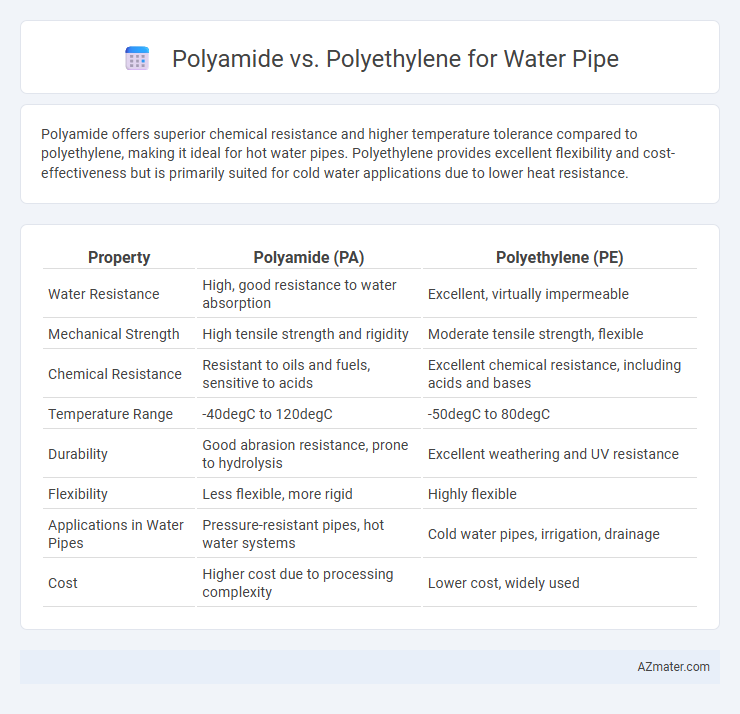Polyamide offers superior chemical resistance and higher temperature tolerance compared to polyethylene, making it ideal for hot water pipes. Polyethylene provides excellent flexibility and cost-effectiveness but is primarily suited for cold water applications due to lower heat resistance.
Table of Comparison
| Property | Polyamide (PA) | Polyethylene (PE) |
|---|---|---|
| Water Resistance | High, good resistance to water absorption | Excellent, virtually impermeable |
| Mechanical Strength | High tensile strength and rigidity | Moderate tensile strength, flexible |
| Chemical Resistance | Resistant to oils and fuels, sensitive to acids | Excellent chemical resistance, including acids and bases |
| Temperature Range | -40degC to 120degC | -50degC to 80degC |
| Durability | Good abrasion resistance, prone to hydrolysis | Excellent weathering and UV resistance |
| Flexibility | Less flexible, more rigid | Highly flexible |
| Applications in Water Pipes | Pressure-resistant pipes, hot water systems | Cold water pipes, irrigation, drainage |
| Cost | Higher cost due to processing complexity | Lower cost, widely used |
Introduction to Polyamide and Polyethylene
Polyamide, commonly known as nylon, is a durable synthetic polymer characterized by high tensile strength, excellent chemical resistance, and thermal stability, making it suitable for demanding water pipe applications. Polyethylene, particularly high-density polyethylene (HDPE), offers flexibility, corrosion resistance, and low permeability, which ensures long-term performance and reliability in water distribution systems. Both materials are widely used in water piping, but polyamide excels in mechanical strength, while polyethylene is preferred for its lightweight and ease of installation.
Chemical Structure Comparison
Polyamide (PA) features amide linkages (-CONH-) in its polymer chain, formed through the condensation of diamines and dicarboxylic acids, providing strong hydrogen bonding and high chemical resistance. Polyethylene (PE), a polymer of ethylene monomers, consists of long chains of saturated hydrocarbons (-CH2- units), resulting in hydrophobic, chemically inert properties ideal for water pipes. The polar amide groups in polyamide contrast sharply with the nonpolar hydrocarbon backbone of polyethylene, influencing their mechanical flexibility, chemical resistance, and suitability for various water pipe applications.
Mechanical Strength and Durability
Polyamide pipes exhibit superior mechanical strength with high tensile strength and excellent resistance to impact, making them suitable for high-pressure water systems. Polyethylene pipes offer good flexibility and chemical resistance but have lower mechanical strength compared to polyamide, which may limit their use in demanding environments. Polyamide's durability in terms of abrasion resistance and temperature stability generally surpasses polyethylene, ensuring longer service life in rigorous conditions.
Resistance to Corrosion and Chemicals
Polyamide water pipes exhibit superior resistance to a wide range of chemicals, including acids, alkalis, and solvents, making them ideal for aggressive water environments. Polyethylene pipes offer good corrosion resistance but can be less effective against certain hydrocarbons and solvents compared to polyamide. When selecting materials for water pipes, polyamide provides enhanced durability against chemical degradation, while polyethylene ensures reliable performance in general corrosion-resistant applications.
Flexibility and Ease of Installation
Polyamide water pipes offer superior flexibility compared to polyethylene, allowing easier maneuvering around corners and obstacles during installation. Polyamide's high resistance to kinking reduces the need for additional fittings, streamlining the setup process. While polyethylene pipes are more rigid, their lower flexibility can complicate installation in confined or uneven spaces.
Temperature and Pressure Performance
Polyamide (PA) water pipes offer superior temperature resistance, functioning effectively in continuous temperatures up to 120degC and short-term peaks up to 150degC, while polyethylene (PE) pipes typically operate within 20degC to 60degC and degrade beyond 80degC. Polyamide also maintains high pressure tolerance, withstanding pressures above 20 bar in hot water applications, compared to polyethylene's pressure limits generally ranging from 6 to 10 bar at room temperature. These properties make polyamide ideal for systems requiring high thermal stability and pressure resilience in demanding environments.
Longevity and Maintenance Needs
Polyamide water pipes offer superior chemical resistance and higher tensile strength, resulting in enhanced longevity compared to polyethylene pipes, which are more prone to UV degradation and cracking over time. Maintenance needs for polyamide pipes are minimal due to their durability and resistance to biofouling, whereas polyethylene pipes often require more frequent inspections and repairs to address wear and potential leakage. The extended lifespan and reduced maintenance costs make polyamide a preferred choice for long-term water pipe installations in demanding environments.
Cost Efficiency and Availability
Polyethylene water pipes are generally more cost-efficient due to lower raw material and manufacturing costs, making them widely available for residential and commercial plumbing. Polyamide pipes, while offering superior chemical resistance and mechanical strength, tend to be more expensive and less commonly stocked by suppliers. Polyethylene's dominance in the market stems from its balance of affordability, durability, and broad availability across various water pipe applications.
Environmental Impact and Sustainability
Polyamide water pipes offer enhanced durability and resistance to chemical degradation, reducing the frequency of replacements and waste generation compared to polyethylene pipes. Polyethylene pipes are generally easier to recycle due to their simpler polymer structure, contributing to a lower environmental footprint in end-of-life processing. Both materials' sustainability is influenced by factors such as production energy consumption, with polyethylene typically requiring less energy, but polyamide's longer lifespan can offset initial environmental costs through reduced resource use over time.
Applications and Industry Recommendations
Polyamide pipes excel in high-pressure water distribution and industrial fluid transfer due to their superior chemical resistance and mechanical strength, making them ideal for automotive, hydraulic, and chemical processing applications. Polyethylene pipes are widely recommended for potable water supply, irrigation systems, and gas distribution because of their flexibility, corrosion resistance, and cost-effectiveness. Industry standards often specify polyethylene for municipal water mains and polyamide for specialized industrial environments requiring higher thermal and abrasion resistance.

Infographic: Polyamide vs Polyethylene for Water pipe
 azmater.com
azmater.com